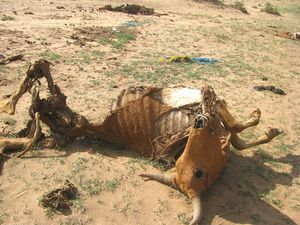
Publisher:
Bonnie King
CONTACT:
Newsroom@Salem-news.com
Advertising:
Adsales@Salem-news.com

~Truth~
~Justice~
~Peace~
TJP
Mar-31-2012 17:14

 TweetFollow @OregonNews
TweetFollow @OregonNews
Drought Affecting Thousands in Somaliland
Submitted by Muthamizh Vendhan for Salem-News.com“Even the families with some livestock can't buy food due to the high prices” - Abdi-Rashid Sh. Mohamed, an elderly man in Baki.
 Photo: Mohamed Amin Jibril/IRIN Some families in the western Somaliland have lost all their livestock in the current drought (file photo) |
(CHENNAI, India) - Officials in the self-declared republic of Somaliland, northwestern Somalia, are appealing for food aid and potable water for thousands of families who have lost their livelihoods in the current drought.
“You can see from far children running to the road waving empty bottles asking you for water and bread or biscuits,” Hussein Muhumed Hog, Somaliland's health minister, told IRIN.
Families in the western Somaliland areas of Garba dadar, Gargaara bari, Gerisa and Osoli have lost all their livestock and do not have regular food supplies, said Hog, adding that other families in the Gargaara and Gerrisa areas (also in the west) are now relying on food provided under the UN World Food Programme’s (WFP’s) food-for-work initiative, and money sent in by Somalis abroad. Ceel la helay, north of the capital Hargeisa, is also affected. In February, WFP provided food assistance to nearly 150,000 people in Somaliland, according to Challiss McDonough, WFP's Senior Spokesperson for East, Central and Southern Africa.
Of those, almost 38,000 were mothers and children under five, with more than 18,600 others receiving family rations or vouchers under the targeted supplementary feeding programme, which provides specialized treatment for malnourished children under five, pregnant women and new mothers diagnosed as undernourished. About 48,000 people also received food through the school meals programme; at least 42,000 received assistance through WFP’S food-for-assets programme and 8,000 others from its food-for-work activities. Food-for-work is a relief activity for communities or families recovering from shocks, while food-for-assets is considered a longer-term activity aimed at strengthening livelihoods.
“Crisis level” food insecurity in some areas
Food security in Somaliland’s Awdal, West Galbeed, Togdheer and Sanaag regions is classified until June 2012 as “stressed”, meaning that households have reduced food consumption, while most of Sool and southern Sanaag are classified as being at “crisis level”, meaning households have significant food consumption gaps with high or above usual acute malnutrition, according to the Food Security and Nutrition Analysis Unit (FSNAU) - Somalia.
In the Baki area of the mid-western Awdal region, for example, the population is still feeling the effects of poor past `Deyr’ short rains.
“Even the families with some livestock can't buy food due to the high prices,” said Abdi-Rashid Sh. Mohamed, an elderly man in Baki. For example, to buy a 50kg sack of sugar valued at US$50, one has to sell two sheep, Mohamed said.
Some 1,800 children in the mountainous rural areas of Baki are also moderately malnourished, Ahmed Mouse Ahmed, the Baki District health officer, told IRIN, adding that expectant and nursing mothers and the elderly are similarly affected.
Malnutrition among IDPs
High malnutrition rates have also been recorded among internally displaced persons (IDPs) in the area of Burco in Togdheer, according to an update by the UN Office for the Coordination of Humanitarian Affairs here global acute malnutrition (GAM) rates of 20.3 percent and severe acute malnutrition (SAM) rates of 4.5 percent were reported in December 2011. The emergency threshold for GAM and SAM is 15 and 5 percent, respectively.
With reduced pasture in predominantly pastoralist regions, concern remains especially if the 2012 `Gu’ (long) rains are below normal.
Rains in the northern regions of Somalia started in mid-October 2011 but as the season advanced, lessened, becoming erratic and ended earlier than expected, according to the US Agency for International Development’s Famine Early Warning Systems Network.
WFP is shifting its focus from emergency assistance towards targeted programmes, including building reservoirs, wells and roads which support communities' resilience to seasonal shocks, according to spokesperson McDonough, who said that in the past year WFP had doubled the number of nutrition programmes in Somalia.
“WFP is using a more targeted approach to relief assistance for people and communities in crisis, including IDPs, using a combination of nutrition programmes and livelihood support programmes, such as food-for-work and food-for-assets, to ensure that immediate needs are met.”
According to OCHA Somalia, “the overall drought situation in Somaliland is relatively less severe currently compared to the very harsh dry season at this time last year [2011] when water trucking was ongoing in almost all the regions in Somaliland.”
maj/aw/cb
Special thanks to IRIN - humanitarian news and analysis
http://www.irinnews.org/printreport.aspx?reportid=95207
 |
 |
 |
 |
 |
 |
Articles for March 30, 2012 | Articles for March 31, 2012 | Articles for April 1, 2012




Salem-News.com:
Quick Links
DINING
Willamette UniversityGoudy Commons Cafe
Dine on the Queen
Willamette Queen Sternwheeler
MUST SEE SALEM
Oregon Capitol ToursCapitol History Gateway
Willamette River Ride
Willamette Queen Sternwheeler
Historic Home Tours:
Deepwood Museum
The Bush House
Gaiety Hollow Garden
AUCTIONS - APPRAISALS
Auction Masters & AppraisalsCONSTRUCTION SERVICES
Roofing and ContractingSheridan, Ore.
ONLINE SHOPPING
Special Occasion DressesAdvertise with Salem-News
Contact:AdSales@Salem-News.com
Terms of Service | Privacy Policy
All comments and messages are approved by people and self promotional links or unacceptable comments are denied.
[Return to Top]
©2026 Salem-News.com. All opinions expressed in this article are those of the author and do not necessarily reflect those of Salem-News.com.